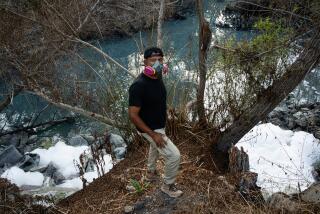Ozone, Acid Rain Damaging Sierra Watershed
- Share via
FRESNO — The Sierra Nevada wilderness is not as pristine as it seems.
Acid rain has been detected in the mountains, and ozone is blamed for slight damage to forest pines.
Scientists are checking tree rings and the survival rate of giant sequoia seedlings, among other things, at Sequoia National Park to develop a biological census that can be used by future researchers.
“We know that we have reason to be concerned as opposed to being alarmed,” said David Graber, a research scientist coordinating federal acid rain research at the park 80 miles east of Fresno.
“The air is moderately dirty because of air pollution produced mostly in the San Joaquin Valley--ozone and oxides of nitrogen, the usual California smog,” Graber said.
The annual report of the state Air Resources Board concluded that the Sierra contains the largest number of lakes and waterways in the state that are sensitive to acid rain.
“We have no evidence at all of any damage being produced by acid rain in the Sierra Nevada,” Graber said.
But, he added: “We have good reason to believe that this park and, for that matter, the entire Sierra Nevada would have very poor resistance to acid rain.”
Acid rain is formed when pollution from factories and automobiles converts to nitric and sulfuric acids. Acid rain damage in so-called quick-response environments similar to the Sierra Nevada could include a decline in fish reproduction and forest tree growth.
Ozone produced by the same pollution sources is blamed for slowed growth and bleached needles on Ponderosa and Jeffrey pines, prime elements in the general tree mixture characteristic of California.
Some scientists believe that the two types of pollution working in combination may aggravate the harm they cause.
More to Read
Sign up for Essential California
The most important California stories and recommendations in your inbox every morning.
You may occasionally receive promotional content from the Los Angeles Times.










